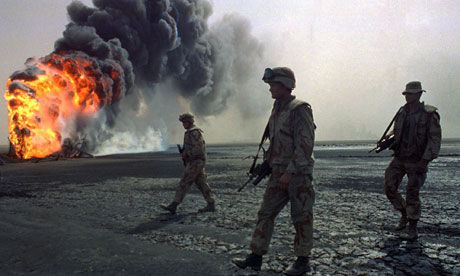Dallas-based Gulf War Illness Study Points to Low Level Chemical Exposure; DMN Ignores
 Shortly before Christmas, a long multi-year toxicological investigation of Gulf War Illness headed up by UT Southwestern's Dr. Robert Haley announced its final conclusions. This is a study that's received lots of attention, and many consider it the definitive work on the Illness to date. Because it involved a local Dallas medical institution and a renowned local scientist, the Morning News traced the study's progress year-to-year, with its penultimate update appearing right after Thanksgiving.
Shortly before Christmas, a long multi-year toxicological investigation of Gulf War Illness headed up by UT Southwestern's Dr. Robert Haley announced its final conclusions. This is a study that's received lots of attention, and many consider it the definitive work on the Illness to date. Because it involved a local Dallas medical institution and a renowned local scientist, the Morning News traced the study's progress year-to-year, with its penultimate update appearing right after Thanksgiving.
Reporting that the study had confirmed that actual physical nerve damage in veterans, and not psychological problems, was the underlying common denominator of the Illness' many different reported symptoms, including breathing difficulties, increased heart rate, decreased sexual function, perspiration and other body functions.
You see, a lot of Very Serious People didn't believe the Gulf War Vets who reported being Ill because they didn't exhibit any of the classic signs of any specific diseases or condition. As it turns out, those same Very Serious People thought the same thing about citizens who were regularly getting shat on by industrial pollution and experienced many of the same kinds of symptoms as the Vets.
Doesn't this sound awfully familiar to some of you?
“Many of these veterans have been told that there is nothing wrong with them,” Haley said Monday in an interview. “Our hope is that the physicians treating our veterans will read this study and recognize the symptoms, and that this will lead to better treatments.”
In the last sentence of the November DMN piece, Haley assured the reporter that the upcoming final chapter of his study would be decisive. Having shown that the Illness was in fact based in physiology and not psychology, Haley was ready now to point the finger at the trigger mechanism itself – what thing or things were causing this physiological response in so many Vets.
“We’re going to show proof of what causes this,” he said. “It will be a huge study with convincing evidence.”
In December, that final chapter was published in a peer-reviewed paper for a respected journal. The New York Times ran an article. And the conclusions were very controversial indeed.
"The paper, published in the journal Neuroepidemiology, tries to rebut the longstanding Pentagon position, supported by many scientists, that neurotoxins, particularly sarin gas, could not have carried far enough to sicken American forces.
The authors are James J. Tuite and Dr. Robert Haley, who has written several papers asserting links between chemical exposures and gulf war illnesses. They assembled data from meteorological and intelligence reports to support their thesis that American bombs were powerful enough to propel sarin from depots in Muthanna and Falluja high into the atmosphere, where winds whisked it hundreds of miles south to the Saudi border.
Once over the American encampments, the toxic plume could have stalled and fallen back to the surface because of weather conditions, the paper says. Though troops would have been exposed to low levels of the agent, the authors assert that the exposures may have continued for several days, increasing their impact."
So the Gulf War Vets not only suffered from some of the same symptoms as downwinders, but they get exposed in the same way downwinders do – a little bit every day. This is the insidious conclusion of the report – that amounts of poison that the regulatory agencies (in this case, the Pentagon) tell you should result in no harm, actually cause harm.
Some scientists studying Gulf War Illness disagree with Dr. Haley. They still hold fast that stress or other psychological conditions cause the Illness. But it's the conclusion of one of the best and most thorough studies of Gulf War Illness ever conducted.
However, you'd be hard-pressed to find anything about it in the Morning News. Unbelievably, the paper didn't cover the final, headline-making conclusion of a study it's been following meticulously for years now. We don't know if the challenge to the status quo was the reason, but it seems like a strange time for the News to wig out.
But taking Dr. Haley's conclusions and overlaying them with what we know about the toxic soup that downwinders often end up being exposed to on a routine basis, one can't help but see the similarities, right down to the "they must be imagining their symptoms" response of the Powers-That-Be. Whether it's the Pentagon, the TCEQ, or EPA, Dr. Haley's research challenges the way we diagnose and protect human health from low-level chemical invasions.
